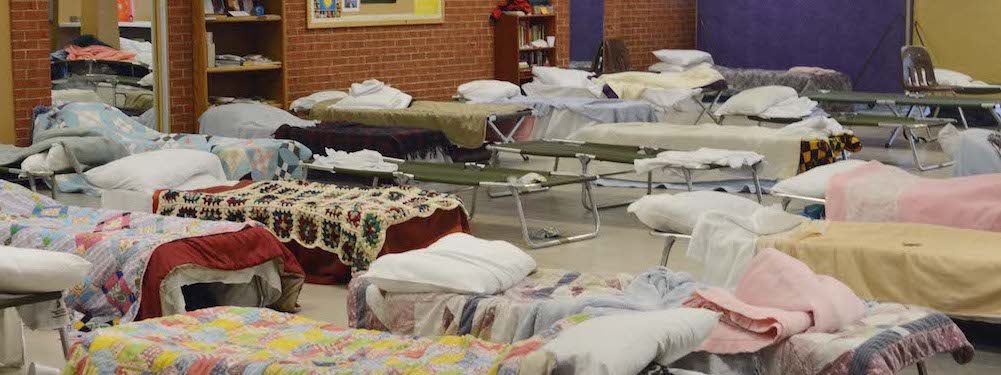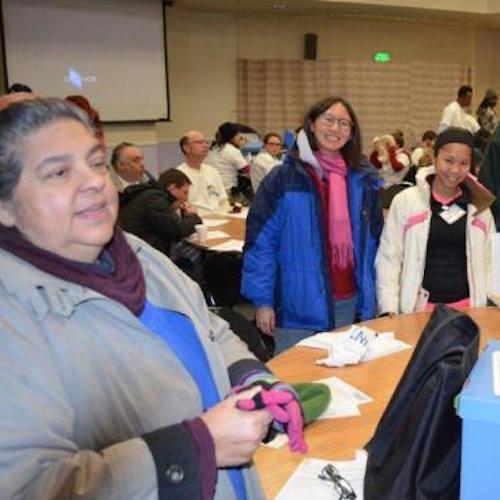 A church provides cots for the homeless during especially cold weather. ©Taylor Pecko-Reid/KOMU8, 2017.
A church provides cots for the homeless during especially cold weather. ©Taylor Pecko-Reid/KOMU8, 2017.
By June Gin
Implications for Public Health
Collaboration between emergency management officials and homeless service providers can ensure that individuals experiencing homelessness are included in planning for disasters, sheltering, response, and recovery.
Individuals and families experiencing homelessness are among the most at-risk members of our society because of limited resources, social isolation, and the prevalence of health conditions within the population. Disasters amplify these conditions, as the social safety nets that the homeless rely on during non-disaster times can be disrupted and even shut down at a time of surging demand.
Recent hurricanes, floods, and wildfires in the United States vividly illustrated the amplified risks that people who are homeless face during catastrophes and the barriers they encounter during community recovery. During the San Diego Hepatitis A outbreak, Hurricane Irma, and the 2018 California wildfires, journalists and researchers documented that individuals experiencing homelessness were perceived as threats due to social stigma and negative perceptions. They also experienced challenges in communities that didn’t fully incorporate the realities of homelessness into plans for emergency response or disaster mitigation. For instance, homeless individuals might not evacuate or take other life-protective measures because of lack of information and distrust of messengers. The ongoing COVID-19 pandemic has further exacerbated these issues.
 Author June Gin, center, participates in a Point-in-Time survey of those experiencing homelessness in Los Angeles. ©June Gin, 2013.
Author June Gin, center, participates in a Point-in-Time survey of those experiencing homelessness in Los Angeles. ©June Gin, 2013.
Challenges from disasters also continue from one year to the next. During the January 2018 Homeless Point-in-Time Count, nearly 3,900 people were living in disaster shelters. The 2018 Camp Fire in California destroyed 14,000 homes in an area that had already declared a homelessness crisis the previous year. As a result, homeless shelters filled to capacity after the fire and displaced residents joined the unsheltered homeless ranks when they could not find anywhere else to go.
During the Point-in-Time Count, 554,000 people were experiencing homelessness in the United States and the U.S. homeless population has increased every year since 2016. This rise is driven largely by an affordable housing crisis in West Coast states such as California, where homelessness increased by 16 percent from 2018 to 2019.
Integrating people experiencing homelessness into disaster planning is a challenge for many communities. Homeless service providers are often disconnected from emergency management and disaster relief organizations; local community-based organizations (CBOs) can lack plans that ensure the ability to provide post-disaster services and housing; and healthcare services for people experiencing homelessness may not be readily available. Many of the CBOs that provide essential daily services and help individuals overcome homelessness have not taken preparedness actions, particularly continuity of operations planning, to ensure they can continue delivering vital services.
Preparing Providers and Other Professionals to Support Homeless Populations
To address these challenges, an evidence-based toolkit—Disaster Preparedness to Promote Community Resilience: Information and Tools for Homeless Service Providers and Disaster Professionals—offers communities research-driven resources and guidance to ensure that the needs of individuals experiencing homelessness are included in disaster planning, response, and recovery. A federal interagency team of researchers and practitioners developed the toolkit by consulting with more than 50 subject matter experts in emergency management, public health, and homeless services to distill best practices and lessons learned.

The toolkit provides an overview of the challenges that occur during and after disasters and the impact of those challenges on people experiencing homelessness. It provides guidance that will help homeless service providers and emergency managers develop partnerships that address the disaster needs of homeless individuals. It also outlines strategies to avoid disruption of services for homeless-serving CBOs and healthcare providers, and includes tips for healthcare settings to ensure that they are adequately staffed with providers experienced in serving people who are homeless.
The toolkit is divided into three sections:
Creating an Inclusive Emergency Management System
Guidance for Homeless Service Providers: Planning for Service Continuity
Guidance for Healthcare Providers
Communities that are engaged in best practices reap the benefits of increased collaboration. The State of North Carolina launched a collaboration—Back@Home—to help local homeless rehousing organizations transition people after Hurricane Florence in 2018. San Diego’s 2017 Hepatitis A outbreak prompted public health officials to build stronger ties with homeless outreach organizations to set up handwashing stations that curb disease spread. During Hurricane Sandy in 2012, Philadelphia’s public health department collaborated with CBOs serving at-risk populations to encourage people living on the street to take shelter. Similar measures were taken in Florida during cold weather episodes, when formerly homeless veterans residing in transitional housing participated in outreach to those living in homeless encampments. After Hurricane Irma in 2017, Florida American Red Cross chapters built on their strong relationships with homeless organizations to help individuals in shelters find permanent housing. Not only did this relationship prevent hurricane-affected individuals from becoming homeless, it also enabled the Red Cross chapters to close the disaster shelters more quickly.
As a living document, the toolkit uses lessons like these to exemplify partnerships that make communities more resilient. By supporting individuals who are experiencing homelessness, this effort can help strengthen the whole community through ensuring that all residents remain safe in disaster.
This toolkit is a joint product of the U.S. Department of Veterans Affairs’ Veterans Emergency Management Evaluation Center (VEMEC), U.S. Department of Health and Human Services’ Office of the Assistant Secretary for Preparedness and Response, and U.S. Department of Housing and Urban Development’s Special Needs Assistance Programs Office. Efforts are currently underway to develop a disaster planning instructional manual for homeless transitional housing provider organizations. For more information, please contact June Gin at june.gin@va.gov.
This article originally appeared in the Research Counts series on January 31, 2018. This is an updated version.
Suggested Tools
Send Red, Not Blue: The Homeless Resident
U.S. Department of Housing and Urban Development
This U.S. Department of Housing and Urban Development report provides recommendations on how to improve communication between local homeless services providers, disaster preparedness planners, and homeless residents themselves. It draws on the experience of two communities that have experienced frequent hurricanes and served homeless families and individuals during a disaster.
Disaster Recovery Homelessness Toolkit
U.S. Department of Housing and Urban Development
A guide to meet the needs of people experiencing homelessness during disaster recovery. It provides recommendations for immediate actions and long-term recovery.
Disaster Preparedness to Promote Community Resilience: Information and Tools for Homeless Service Providers and Disaster Professionals
U.S. Department of Veterans Affairs’ Veterans Emergency Management Evaluation Center
A toolkit offering communities research-driven resources and guidance to ensure that the needs of individuals experiencing homelessness are included in disaster planning, response, and recovery.
For a list of all the tools included in this special collection, visit the Mass Sheltering Tool Index. A list of further readings are also available.
June Gin is a research health scientist at the Veterans Emergency Management Evaluation Center. She works to create evidence-based tools and resources to improve disaster preparedness in community-based organizations serving homeless veterans and leads projects to strengthen the preparedness of safety net organizations serving individuals experiencing homelessness.